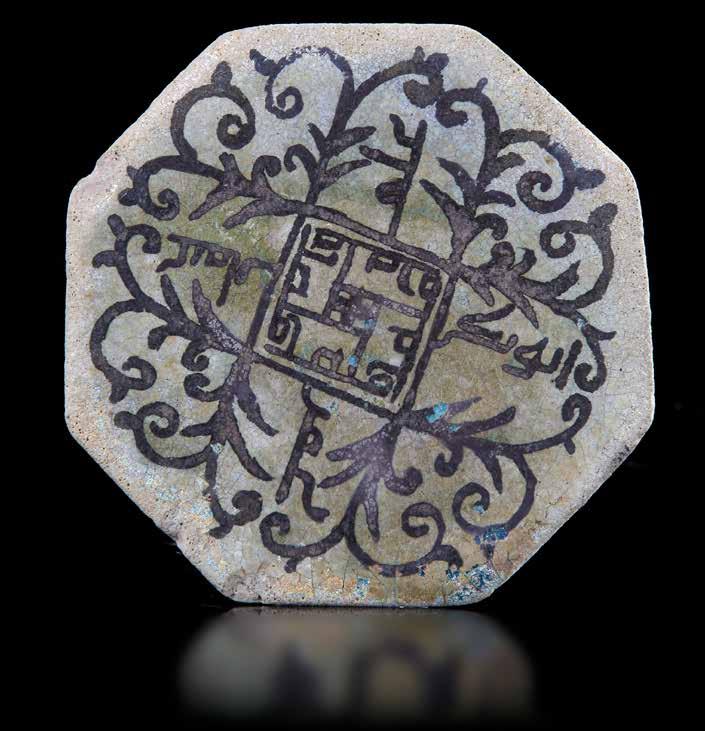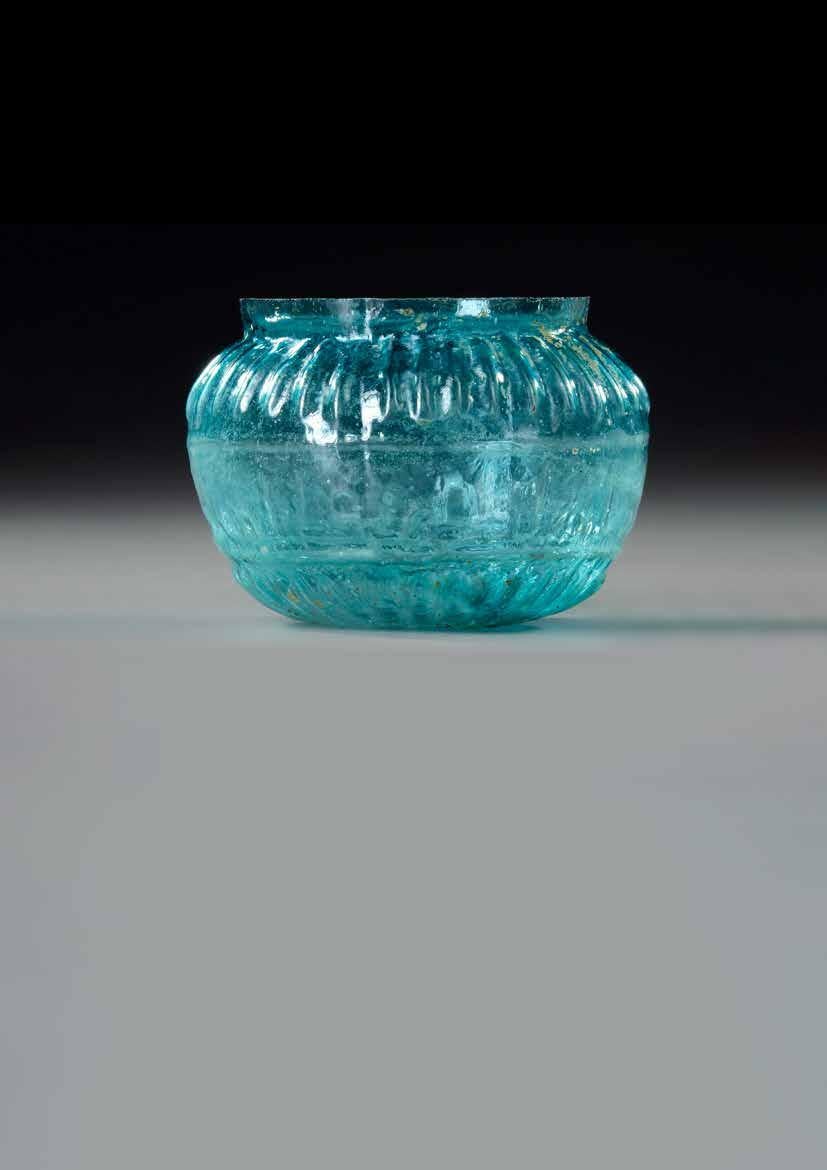
5 minute read
A KASHAN LUSTRE ALBARELLO, PERSIA, 12TH-13TH CENTURY
Cylindrical pot supported by a ring foot, small shoulder and low neck with rim round. The decoration reproduces an inscription in Kufic, which repeats the word several times ‘Allah’ on the body; while on the shoulder, the inscription, with a thinner and faster line, seems correspond to pseudo-Arabic (the painter probably did not speak or write this language). The texts are rendered in negative, since they come out in white (the color of the glaze) between the golden brown outlines of the paint. The function of these pots was, originally, that of containing spices (in Iran from the 9th century and in Syria a little later, from the12th century), but also drugs and ointments used in pharmacy. Called al-biram in Arabic (earthen pots), they will experience great fervor also in Europe under their Italian name of albarelli. The execution technique, called the metallic luster technique, is one of the most important contributions of Islamic craftsmen to the development of ceramics. Earth fired (light beige in this case) is first covered with a glaze (here creamy white) and then baked for the first time in an oxidizing atmosphere up to about 900o -1000o.
After cooling, the decoration is executed with a mixture based on silver oxides and/or of copper mixed with ocher and diluted with vinegar: the vase is then annealed, this time in a furnace without oxygen supply (reducing atmosphere), at a lower temperature (600o -700o). The glaze, softened by the heat, can thus incorporate the paint into a very thin and very shiny. Probably invented in Iraq, the center of power of the Abbasids, between the 8th and 9th centuries, this technique was widely used by the potters of Cairo under the Fatimid dynasty, in the 10th and 11th centuries, before being transmitted to the Iranian and Syrian worlds.
Advertisement
Conditions: Complete, in excellent condition. Minor chipping or chipping (foot); paint very shiny, in places a little faded, especially on the inside.
Height: 12 cm
PROVENANCE
Private collection, Switzerland
Bibliography
Terres d’Islam, The Middle Eastern ceramic collections of the Ariana Museum in Geneva, Geneva, 2014, no. 63, p. 73-74; no. 68, p. 83. WATSON O., Ceramics from the Islamic Lands, Kuwait National Museum: The Al-Sabah Collection, London, 2004, pp. 289ff; p.p. 346ff.
Estimate € 20.000 - € 30.000
Lot 45
A KASHAN LUSTRE SPRINKLER FOR ROSEWATER, PERSIA, CIRCA 1200
A Kashan lustre pottery rosewater sprinkler with squat circular body and tapering neck with everted rim, painted in dark and yellowish brown on a cream ground, with bands of cursive calligraphy and birds amidst foliage, kufic inscriptions and foliate motifs in bands encircling the neck.
Inscriptions: verses in Persian. Lustre rosewater sprinklers are unusual, stylistically this piece belongs to Watson’s third Kashan type.
Height: 18.5 cm.
PROVENANCE
Ex. Sotheby’s London , 25th April 1996, lot 46
Estimate € 14.000 - € 18.000
Lot 46
A LUSTRE PAINTED TURQUOISE GLAZED OCTAGONAL TILE
SYRIA, 11TH-12TH CENTURY
The octagonal tile painted with a central square panel issuing scrolling floral designs from each corner, the central square panel filled with four renderings of the name of the Prophet Muhammad, surrounded by the first four caliphs, glaze completely and evenly iridised.

Diameter: 11.2 cm.
The style of script seen here, coupled with the form of the scrolls, clearly both point to an origin that is not in line with pottery from 13th century Kashan or Syria. The form of the waw in Abu Bakr however indicates a date of the 11th or 12th century, probably no earlier.
PROVENANCE
Ex-Swiss private collection
Christie’s Lnd, Art of the Islamic and Indian Worlds, 7 oct. 2008, lot 1412
AN ISLAMIC VASE WITH ZOOMORPHIC HANDLES, PERSIA, KASHAN LATE 12TH-EARLY 13TH CENTURY AD
Siliceous paste,
The thin-walled, fragile vase is supported by a small annular foot; its spherical but squashed body ends in a vertical rim. The two handles are modelled in the shape of panthers arranged vertically, the hind legs resting on the body of the vase and the front ones higher up, near the lip. The potter added two cylindrical false necks, shaped like the neck of a swan, at the rim and between the handles. Their purpose was probably decorative, as they are not pierced towards the inside of the vase.
The painted scene and its rich polychromy, based here on the use of blue, reddish-brown and sky-blue, brown and black, on the greyish-white surface of the vessel, are typical elements of the Islamic ceramic style known as minâ’i. The frieze, which runs the full length of the available space, features four horsemen on their mounts, riding towards the viewer’s left: they are separated by polychrome geometric motifs. An inscription imitating Arabic characters adorns the inside of the border. The riders are dressed in a sleeved tunic and wear trousers; their feet are slipped into the stirrups.
The ceramics, known as minâ’i (a Persian term in modern usage meaning glazed) or haft-rang (Persian for “seven colours”), use the technique known as petit feu decoration, a highly elaborate process that sometimes involves up to three different firings: one for the paste and glaze, another for the metallic lustre, when present, and the last to fix the colours.
In vogue for only a few decades between the end of the 12th and the beginning of the 13th century AD, minâ’i ceramics represent one of the most important developments in Islamic ceramics: its centre of production was in Kâshân, in central Iran.
The technical difficulties involved in making these vessels and the fragility of the finished product meant that they were highly luxurious objects intended exclusively for the wealthier classes. Complete and in good condition, but glued back together from a large number of fragments; frequent re-filling and paint retouching.
Height: 17.5 cm
Provenance
Private collection, Switzerland
Formerly Japanese collection, collected in the 1980-90s.
Bibliography
Terres d’Islam, Les collections de céramique moyen-orientale du Musée Ariana à Genève, Geneva, 2014, nos. 70-72, pp. 84-85.
VON FOLSACH K., The David Collection, Islamic Art, Copenhagen, 1990, pp.76, 99, no. 115.
WATSON O., Ceramics from the Islamic Lands, Kuwait National Museum: The Al-Sabah Collection, London, 2004, pp.364ff.
Estimate € 10.000 - € 15.000

Lot 48
A KASHAN LUSTRE POTTERY BOWL, PERSIA, DATED 602 AH/1206 AD

Of deep conical form, painted in lustre heightened in cobalt blue and turquoise on a cream ground, with a central medallion of swimming fish against a ground of cursive scrolls encircled by a border of sgraffiato calligraphy, the sides with six panels alternately depicting seated princely figures and speckled leopards, divided by vertical bands of calligraphy, the exterior with a band of four cartouches below a now obscured border of calligraphy.
Inscriptions: verses in Persian and dated on the outer rim 602 AH / 1206 AD.
Height: 11.8 cm.
Diameter: 28 cm.
Estimate € 40.000 - € 60.000
PROVENANCE
Ex. Kelekian Collection, Label “lent by Kelekian”, n°53, Ex. Sotheby’s London 1996, lot14.
Exhibited: Formely on loan to the Victora & Albert Museum. With three labels inside the footring, two inscribed with numbers, the third ‘LENT BY Kelekian No. 53’.

Literature
Pope: Survey of Persian Art, vol II, pp. 1634-35, vol V, pl. 719 A
Lot 49
MUNAJAT OF IMAM ‘ALI BIN ABI TALIB, PERSIA SAFAVID, DATED 1028 AH/1628 AD
Ode to God, the forty sayings of the Imam ‘Ali, Arabic and Persian manuscript on paper, 18 leaves, each folio with 7 lines of large black Arabic nastaliq script alternated with panels of diagonally written smaller black Persian nastaliq script, text panels ruled in gold and polychrome borders, with pink paper margins decorated with gilt birds perched amongst floral motifs.
Opening folio with fine gold and polychrome illuminated headpiece, colophon signed Abdul-Jabar and dated 1038 AH, with ownership statements and seals.

In fine later Qajar lacquer binding decorated with central medallion filled with elegant scrolling vine.
12.5 by 19.5 cm.
Estimate € 10.000 - € 20.000










